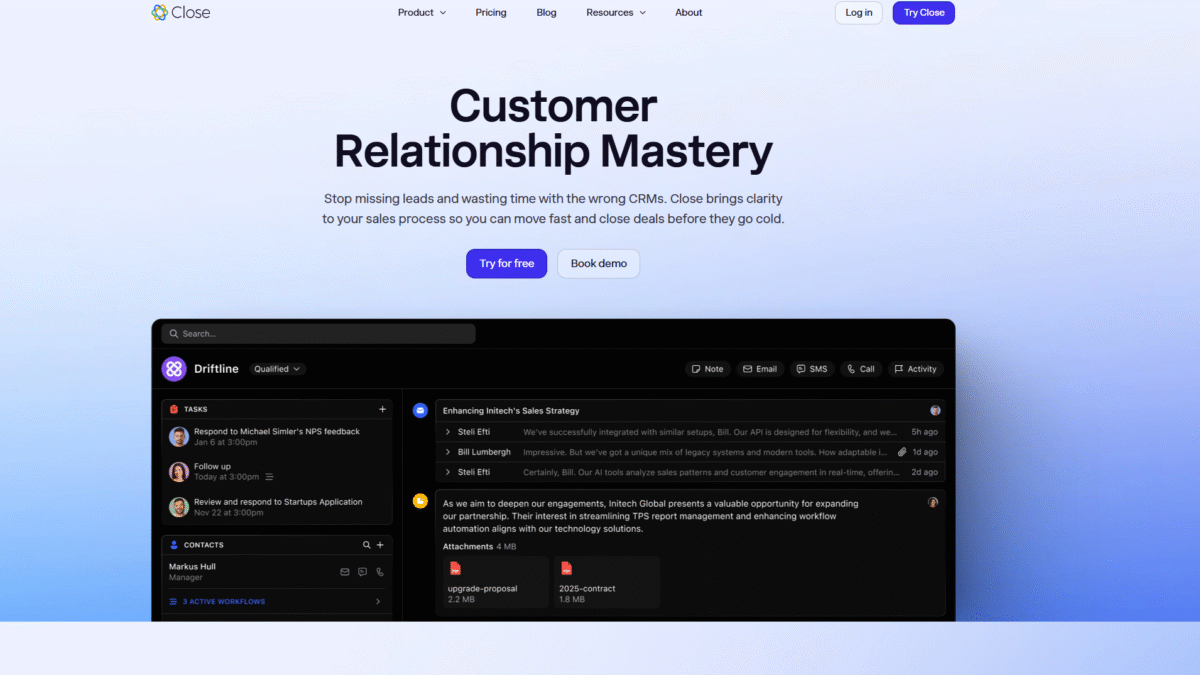
Optimize Your Sales Pipeline Stages for Maximum Growth
Are you looking to fine-tune your sales pipeline stages for maximum efficiency and growth? You’ve come to the right place. By implementing the right framework and leveraging an intuitive tool like Close CRM, you can shorten sales cycles, boost conversion rates, and foster stronger customer relationships.
Understanding Sales Pipeline Stages
The term sales pipeline stages refers to the distinct phases prospects move through on their journey from first contact to closed deal. Mapping out each stage clearly helps sales teams predict revenue, identify bottlenecks, and allocate resources more effectively. Without a well-defined pipeline, deals can slip through the cracks, follow-ups get missed, and forecasting becomes guesswork.
Why Optimizing Each Stage Matters
An optimized pipeline does more than just look neat on paper. It drives:
- Higher conversion rates by ensuring prospects receive the right nurturing at the right time.
- Shorter sales cycles by eliminating unnecessary steps and focusing on high-value activities.
- Accurate forecasting so you know where revenue will come from months in advance.
- Improved team alignment as everyone follows a clear, consistent process.
Common Sales Pipeline Stages
While every organization’s pipeline might differ slightly, most pipelines follow these core stages:
- Lead Generation: Gathering new prospects through marketing campaigns, referrals, events, and inbound inquiries.
- Qualification: Determining whether a lead fits your ideal customer profile and has the budget, authority, need, and timeline to buy.
- Needs Analysis: Conducting discovery calls or meetings to uncover pain points, priorities, and decision-making criteria.
- Proposal: Presenting a tailored solution, pricing, and scope of work in a formal document or presentation.
- Negotiation: Addressing objections, refining terms, and ensuring both parties agree on deliverables and pricing.
- Closing: Securing the commitment via contract signature or purchase order, and handing off to onboarding or fulfillment teams.
- Post-Sale Follow-Up: Ensuring customer satisfaction, upsell opportunities, and generating referrals for future business.
Optimizing Each Stage for Maximum Growth
Lead Generation
Attracting the right prospects lays the foundation for a healthy pipeline. To optimize:
- Use targeted ads and content marketing to reach your ideal audience.
- Leverage referral programs and partnerships to gain warm introductions.
- Qualify inbound inquiries quickly to avoid wasting time on low-fit leads.
Qualification
Speed is crucial once a lead expresses interest. Implement:
- Automated qualification workflows that assign scores based on responses or firmographic data.
- Custom fields in your CRM to capture budget, authority, need, and timeline (BANT) information.
- Built-in email and calling tools, like those in Close CRM, to ensure follow-up happens within minutes, not days.
Needs Analysis
A deep understanding of a prospect’s pain points sets you apart from competitors. Best practices include:
- Structured discovery call scripts stored in your CRM to guide reps through every question.
- Recording calls and adding notes automatically for better team collaboration.
- Using custom activities in Close CRM so you never miss a critical piece of information.
Proposal
Personalization drives higher proposal acceptance rates. Optimize by:
- Pre-built proposal templates that merge prospect data automatically.
- Integrating e-signature tools within your CRM to speed up approval.
- Tracking proposal opens and link clicks to gauge prospect interest.
Negotiation
Stay on top of objections with:
- Real-time notifications when prospects revisit pricing pages or proposal documents.
- AI-powered email assistants that draft clear, persuasive response templates.
- Automated reminders to follow up if no response is received within a set timeframe.
Closing
Reducing friction at the finish line is essential. Consider:
- Automating contract generation and sending via your CRM.
- Streamlining payment collection by integrating billing systems.
- Setting up onboarding tasks to kick off once the contract is signed.
Post-Sale Follow-Up
Growth doesn’t end at the sale. Encourage renewals and referrals by:
- Scheduling automated check-in emails and review requests.
- Tracking customer health scores within your CRM dashboard.
- Creating upsell campaigns based on usage data or subscription milestones.
How Close CRM Streamlines Your Sales Pipeline
Managing multiple stages manually is tedious and error-prone. Close CRM unifies every step from prospecting to post-sale in one platform. Key advantages include:
- Built-in calling, email, and SMS so reps never switch tabs.
- Customizable pipelines and stages to mirror your unique process.
- Automated workflows that trigger reminders, status updates, and task assignments.
- Real-time reporting on stage duration, conversion rates, and revenue forecasts.
Ready to see it in action? Try Close Free for 14 days Today and watch your pipeline transform.
Best Practices for Maintaining a Healthy Pipeline
Even with the right tool, discipline is key. Adopt these habits:
- Daily Pipeline Reviews: Block time each morning to review progress and unblock deals.
- Regular Data Cleanup: Eliminate duplicates and update contact details to keep metrics accurate.
- Consistent Follow-Up Cadence: Automate reminders so no lead goes cold.
- Team Training: Host weekly workshops on objection handling, call scripts, and pipeline hygiene.
Measuring Success and Iterating
Track these metrics to evaluate improvements in your sales pipeline stages:
- Stage Conversion Rates: Percentage of deals that progress from one stage to the next.
- Average Stage Duration: Time prospects spend in each stage before moving forward.
- Sales Cycle Length: Total time from initial contact to closed won.
- Deal Velocity: Number of deals closed per month.
Use these insights in Close CRM’s dashboard to pinpoint bottlenecks and refine your approach continuously.
Conclusion
Optimizing your sales pipeline stages is a strategic investment that accelerates growth, improves forecasting accuracy, and boosts team productivity. With Clear visibility into each phase, automated follow-ups, and built-in communication tools, Close CRM empowers you to close more deals in less time. Ready to unlock peak performance? Try Close Free for 14 days Today and revolutionize your sales process.
